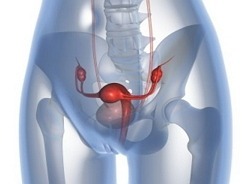All you need to know about the contraceptive spiral
 Many women seek reliable methods of contraception. To date, there are many pharmaceutical products, as well as gynecological drugs that help to avoid unwanted pregnancies. Intrauterine spirals are considered a very popular method of contraception.
Many women seek reliable methods of contraception. To date, there are many pharmaceutical products, as well as gynecological drugs that help to avoid unwanted pregnancies. Intrauterine spirals are considered a very popular method of contraception.
In contrast to temporary contraceptives, intrauterine devices have a lasting effect. They can be placed for a different period of time - from five to ten years. The principle of their action is very simple: they do not allow the matured ovum to go out for fertilization. Spirals are of two types - hormonal and copper. Their cost is also different. It depends on the firm of the manufacturer, from the clinic, where the spiral is put.
The IUD( intrauterine contraceptive spiral) of the latest generation contains the levonorgestrel hormone. Every day a daily rate of this hormone is released into the uterus, which prevents pregnancy. Sometimes such spirals are introduced in the treatment of various gynecological diseases.
Some history of the
Navy appeared relatively recently - only 80 years ago. Since then they have become much better and more effective. The first spiral was in the form of a ring, plate or rod, which was made of precious metal. In the early 70's, doctors developed plastic flexible spirals that protected from pregnancy, but had a lot of side effects. Women with such spirals often had heavy bleeding, pain and other effects.
With every subsequent decade, the design of the spirals has been improved. They became smaller in size and safer for health. To date, they are considered one of the best methods of contraception.
How the Navy
works It has already been said that today there are two types of IUDs: hormonal and copper. Below consider each of these types:
-
Copper IUDs are made from a certain metal alloy. They suppress the activity of spermatozoa. The uterus produces a fluid that destroys spermatozoa and interferes with the fertilization of the egg. Such a spiral thinning the walls of the endometrium. Put such a spiral for 10 years.
-
IUDs with hormone are very effective. Every day from such a spiral a daily dose of a hormone is allocated, which provokes the release of mucus from the uterus and prevents the full attachment of the egg. Such spirals help in the treatment of certain gynecological diseases. They are put on for 5 years.
What spirals look like and what are their advantages.
Both types of spirals are practically identical. They are made in the form of the letter "T".At the heart of the spiral is a container with a hormone. Spirals of metal consist of a base on which a copper or silver wire is wound.
Advantages of the Navy :
-
if the spiral is correctly installed, it protects against unwanted pregnancy by 99%;The
-
helix is injected very quickly and easily - in just five minutes;
-
spiral is put on for 5-10 years, which is very convenient for a woman;
-
spirals are available in price;
-
after the spiral the weight is not added, as after taking hormonal tablets;
-
The IUD can be prescribed for those women who can not take oral contraceptives;
-
spiral begins to act as soon as it is installed;
-
after the extraction of the spiral reproductive function will be restored and the girl will be able to immediately become pregnant.
Many girls think about what is better - oral contraceptives or a spiral? Uniquely wins the spiral. After all, she will not have to worry about that you did not drink the pill in time. In addition, the spirals have no effect on the figure, which can not be said about hormonal tablets.
How the intrauterine device
Before deciding on such a procedure, it is necessary to find an experienced doctor. After all, efficiency will depend on this. It is best to choose doctors who have positive feedback about their work. Before sending the patient to such a procedure, the doctor will definitely conduct a survey. In some cases, it is necessary to pass tests to make sure that there are no inflammatory processes.
For a couple of days before the procedure, you must refrain from any sexual intercourse. In addition, you can not do syringing, use candles or tablets, unless the doctor himself has appointed it. It is best to enter the intrauterine device for 1-7 days of menstruation, when the cervix is softer. Thanks to this, the spiral is introduced much easier.
The intrauterine device is installed in a sterile office on an outpatient basis. Installation time is only 5 minutes. Before the introduction of the spiral, the doctor treats the cervix with an antiseptic. During the introduction of the spiral, the girl can feel unpleasant tingling, pain in the abdomen. This is due to the fact that the doctor pulls the cervix with a special tool to straighten it. Such manipulations allow you to set the spiral in the correct position.
Immediately after the introduction, a woman may experience dizziness. Sometimes acute acute pain occurs. But these symptoms pass independently after half an hour after the installation of the spiral. If the symptoms do not disappear, the doctor re-examines the patient. Perhaps the spiral was entered incorrectly. In such cases, it is extracted and installed a new one.
During the day after installation, the girl can feel aching pain in the lower abdomen. This is considered normal. Also can last for a month - for two days. After the introduction of the spiral, in no case should you have sex for a week and you can not use tampons or any drugs, including aspirin.
After the introduction of the IUD, you can not visit the sauna, swimming pool, beach or sunbathing in the sun( in the solarium).Also it is necessary to refuse for a while from physical activities. A month after the installation, you need to visit a doctor and make an ultrasound to see if everything is fine. If the spiral is correctly placed and the woman does not experience any discomfort, she will simply need to visit the gynecologist twice a year later.
Important to know
-
IUDs can be installed after abortion in the first months.
-
If a woman has a miscarriage, then the spiral can be installed not earlier than one and a half months after this.
-
After delivery, gynecologists are advised not to install a spiral during the first three months. The body must recover.
-
The spiral needs to be removed at the time - in five to ten years.
-
After removing the old spiral, you can immediately install a new one.
-
Each time after the end of menstruation, it is necessary to check the antennae of the spiral in the vagina. If the antennae are shorter or they are not, then you should immediately contact a gynecologist.
Who is contraindicated to the Navy
IUD can only be installed by women who have given birth. Also, this method of contraception is suitable only for those who have sex with a single partner. After all, such a spiral can protect against pregnancy, but it does not protect against diseases that are sexually transmitted.
The spiral is not set if the woman has inflammatory processes or gynecological diseases. Before installing the spiral, the patient must be examined. In no case should spiral be established during pregnancy, with malignant and benign tumors, with chronic diseases, with hormonal disorders, and with mastopathy.
Side effects of
At first, after the IUD installation, the following side effects may occur:
-
nausea;
-
spiral fall;
-
inflammation of the mucous membrane of the cervix;
-
swelling;
-
copious monthly;
-
back pain;
-
increased appetite;
-
no monthly.



